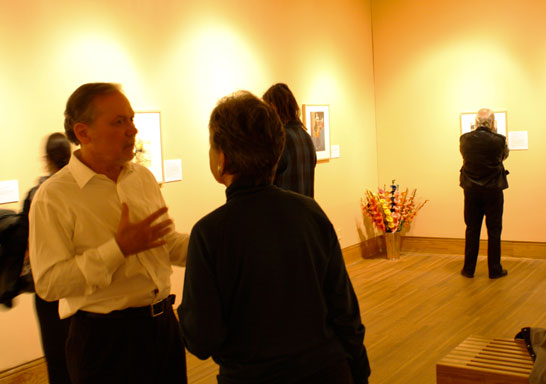
Nuns at Border (Courtesy of Bruce Berman)
EL PASO — The brisk pace of life carved into the faces in Bruce Berman’s photographs carries stories of the humor, sadness and diversity that exist along the U.S.-Mexico border.
The gallery at the University of Texas at El Paso’s Centennial Museum rang with excitement as the crowd that gathered for the event drew from Berman’s energy as he entered the room.
“What am I thinking? I’m too old for this,” said Berman. But his eyes told otherwise as he sat in the middle of the room, surrounded by the framed moments he had captured through the lens of his camera. Each photograph seemed to tell a different story from the same book.
“These photos are not at all about me,” Berman said, “They are absolutely about the people in the stories.” His exhibition was a collection of pictures taken along the El Paso-Juarez border. The images included the stern look of a child sitting in the drivers seat of a car, an exiled Juarez artist and a mind-blowing shot of a group of nuns talking through a fence at the edge of the world —half standing in the barrio of Anapra in Juarez, half standing in the town of Anapra in New Mexico.

Photographer Bruce Berman at Centennial Museum (Raymundo Aguirre/Borderzine.com)
“I think my issue is redefining the words poor and rich. What I‘ve learned from all the people I’ve shot from Appalachia till now is I have never felt poor in this community. I’ve never looked at poor people. I’ve never seen poor people. These are the richest people, and we kind of need to start redefining what that means,” Berman said.
Berman has been a professional photographer for the last 41 years. “I remember my earliest assignment. October 11th 1967 . . . It was the last public demonstration of the SDS Weathermen,” he said. The Weathermen were an American radical leftist organization that called for the violent overthrow of the government. “I got that assignment because I was stupid. I’m the only one who would accept it. Everyone knew it would be violent,” said Berman with a laugh.
Berman teaches photography at New Mexico State University. “I tell my students, I want you to use photography as an instrument of education, not self-expression so that you can matter. I really, really mean that. You’ll matter if you involve yourself in other people’s lives,” Berman said. NMSU recently received a large grant to push forward into the age of multimedia journalism, he said.
It is interesting to wonder what keeps a man with such a long and proud career as a journeyman photographer going. “I’ve got work to do on the border. This is the end of this era, really,” Berman said. He pointed at a portrait of an aged woman with a Mona Lisa smile in the corner of the room. The photo was labeled The Artist. “I wanted that to be the last photo. The one of the woman who got chased out of Juarez,” Berman said.
“You know, people have been fleeing for a year and a half, but they weren’t the people I wanted to photograph. I wanted to photograph, like I always photograph, just the regular, normal people,” Berman said.

Mago Gandaro by photograph of herself (Raymundo Aguirre/Borderzine.com)
“The next body of work will be, I think, a portrait series about people in Juarez surviving the situation or people who have fled the situation,” Berman said. He referred to the Ciudad Juarez violence that fills the news day after day.
Nothing seemed out of place at the exhibit until one wonders why these photographs are in a museum and not an art gallery. “This is a document. People go to museums to see documents,” said Berman about his choice in location, “I hope there is enough information here that you can start to understand that there is a community in this border that doesn’t need fixing exactly; we’re always talking about downtown plans and redevelopment. There is nothing wrong with this community.”
Berman is no stranger to El Paso’s Segundo Barrio. “I live in this community. I live in the barrio still. Thirty-one years in the barrio,” Berman said. This complete integration into the culture of the region and its people has allowed him to make the border the main focus of his work for the last 26 years.
“I like to go into those communities and show their richness, and take that information out, use it as an instrument of education, and pass it on to a community that really doesn’t see that in these people,” he said about his photography on the border. “That’s why people do photo-journalism, to pass information for making things better, that’s my intention for the exhibition.”

Row of visitors to the Border Stories Exhibit (Raymundo Aguirre/Borderzine.com)


I loved this article! The story is very meaningful, especially to those native to El Paso and Juarez. The article is written with a lot of heart, you capture the essence behind someone who understands what it is to live in the border. Congratulations! You really captured Berman and his photographs.
Great story.
‘Whatever is true, whatever is noble, whatever is right, whatever is pure, whatever is lovely, whatever is admirable if anything is excellent or praiseworthy think about such things.’ Glad to see Berman Intention is to look for rich where others see poor :).
Congratulations Raymundo for putting words to his vision.
I liked the comment that the border does NOT need fixing. I disagree with the comment that education comes before self-expression in photography. Self expression matters, and what is teaching anyway but self expression and learning a means to self express.